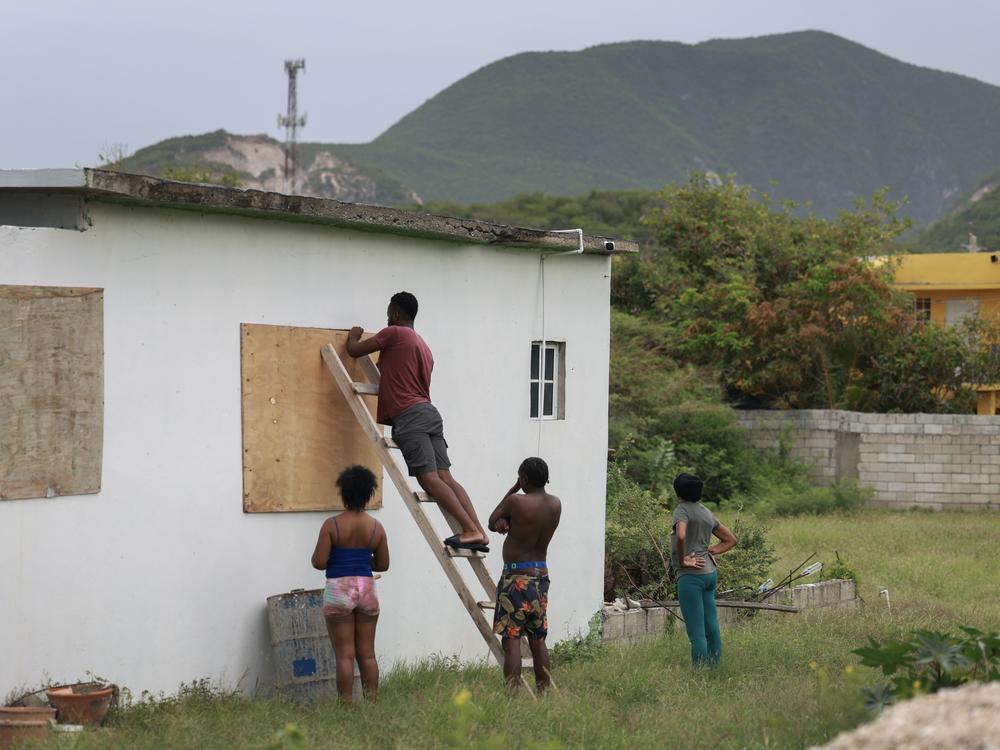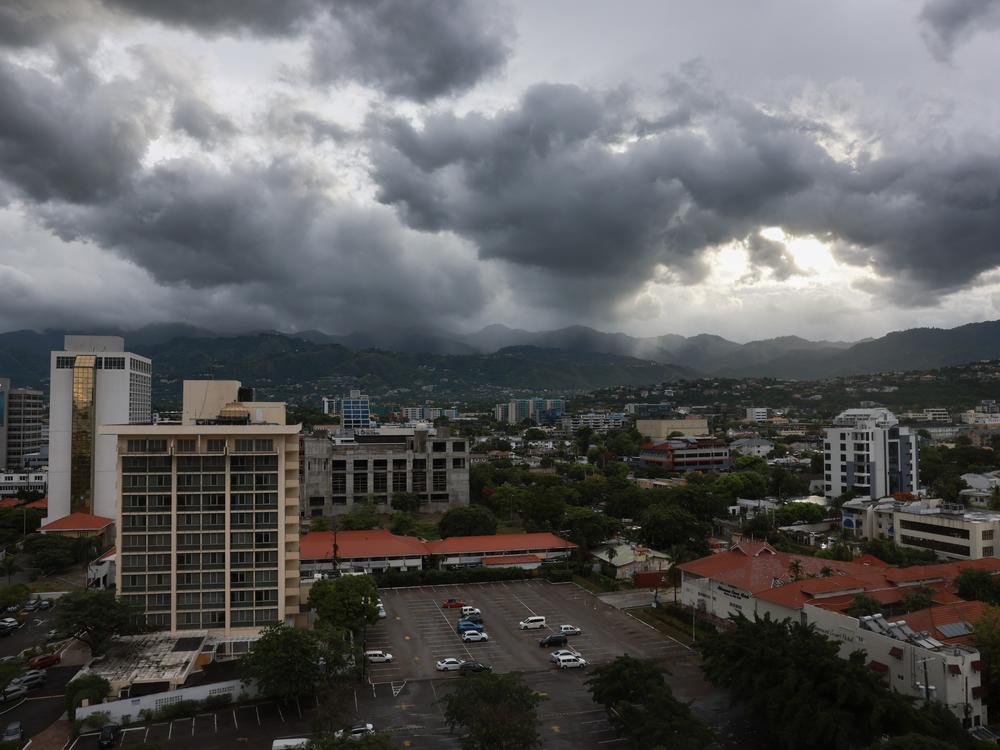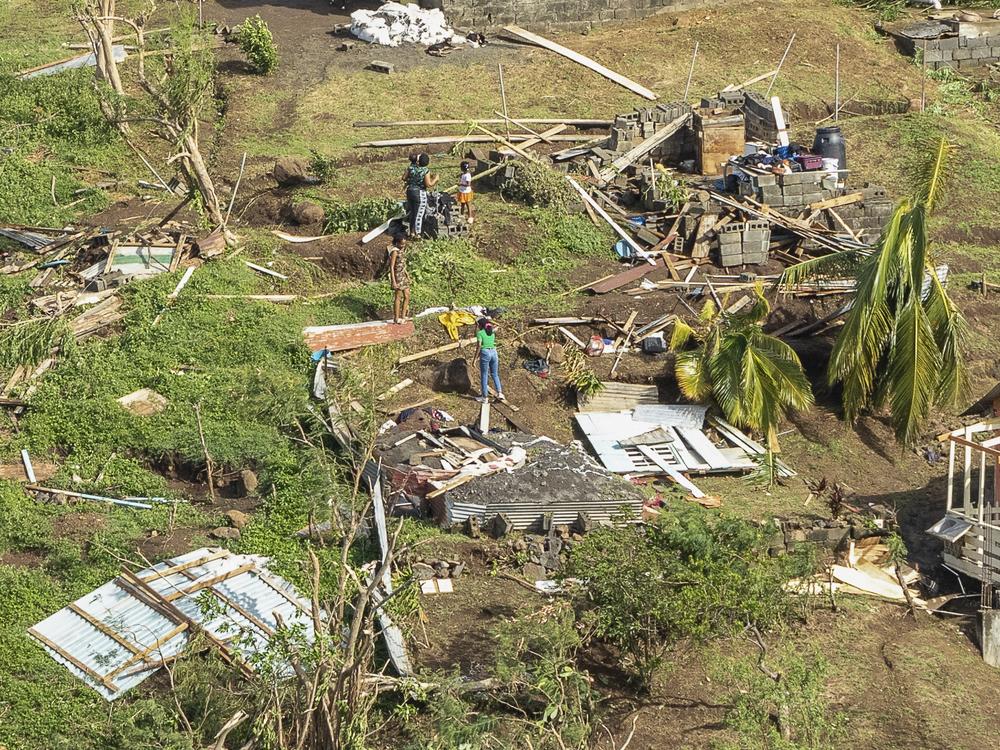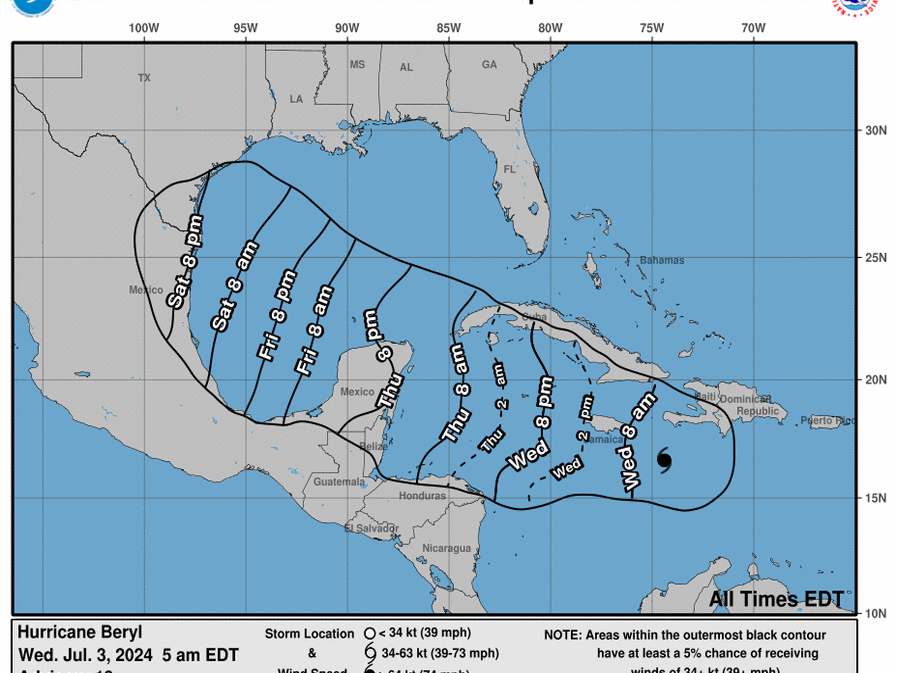Section Branding
Header Content
Hurricane Beryl roars toward Jamaica after battering southeast Caribbean islands
Primary Content
Hurricane Beryl is hurtling toward Jamaica as a Category 4 storm after weaving a path of destruction across several southeast Caribbean islands.
The National Hurricane Center (NHC) said the center of Beryl was about 75 miles southeast of Kingston as of 11 a.m. ET, and due to pass near or over the island "during the next several hours."
"Devastating hurricane-force winds, life-threatening storm surge and damaging waves are expected to begin in Jamaica within the next few hours and spread into the Cayman Islands tonight," it said.
It warns that tropical storm conditions are already spreading across Jamaica, making outdoor preparations difficult.
Beryl, with its maximum sustained winds near 145 miles per hour, remains dangerous despite being downgraded from a Category 5 on Tuesday. It killed at least six people, slashed power, destroyed buildings and blocked roads as it tore through Grenada and Saint Vincent and the Grenadines, according to the Associated Press.
“The good news is that Beryl has begun weakening a little bit,” NHC Director Michael Brennan said in a late Tuesday video update. “But those peak winds are only going to come down very slowly over the next couple of days, and we’re still expecting Beryl to be a powerful major hurricane when it reaches Jamaica.”
The NHC warns that Beryl could dump four to eight inches — and in some places as much as a foot — of rain across Jamaica through Wednesday evening, and that storm surge could raise water levels by up to 9 feet above normal tide levels.
It says flash flooding and mudslides from heavy rainfall are expected over much of Jamaica and parts of Haiti, and that mountainous areas could experience "destructive" wind gusts.
All three of Jamaica’s international airports are closed on Wednesday, and officials say the island’s electricity and water service will likely beshut off as a precaution to prevent fires and protect equipment.
Jamaican Prime Minister Andrew Holness has declared a “major disaster area” and implemented an island-wide curfew from 6 a.m. to 6 p.m. local time, based on what he called the “strength, path and potential threat” posed by Beryl.
“This is to ensure the safety of everyone during the passage of the storm and prevent any movement with the intent to carry out criminal activity,” Holness said in an Instagram video.
The NHC has a hurricane warning in place for Jamaica and all three of the Cayman Islands, where the center of the storm is expected to pass late Wednesday into Thursday before moving over Mexico’s Yucatan Peninsula on Friday. The coast of the peninsula, from Puerto Costa Maya to Cancun, is under a hurricane warning as of late Wednesday morning.
Jamaica’s size — at some 146 miles long and 51 miles at its widest point — makes it an unlikely target of a direct hit from a hurricane. Only two hurricanes have made landfall there in the last 40 years, CNN notes: Sandy in 2012 and Gilbert in 1988.
Caribbean islands are taking stock of widespread damage
Beryl has already wreaked havoc on several countries in the eastern Caribbean Sea. Photos emerging from the hardest-hit islands show roofs torn from buildings, fishing vessels ripped apart and roads flooded with water and sand.
Some of the worst damage appears to have occurred in Carriacou and Petite Martinique, two small islands in Grenada.
Officials said about 98% of buildings on the islands — which are home to some 6,000 people — had been damaged or destroyed, including Carriacou’s main health facility, according to the New York Times. Three storm-related fatalities have been confirmed there so far, per the AP.
“The possibility that there may be more fatalities remains a grim reality as movement is still highly restricted,” Prime Minister Dickon Mitchell said at a news conference on Tuesday.
Two other deaths have been reported in northern Venezuela’s Sucre state, where authorities said another five people are unaccounted for and a total of 25,000 have been affected by heavy rains, winds and river flooding from the outer bands of the storm.
Venezuela’s Vice President Delcy Rodríguez was injured after being hit by a falling tree while visiting one of the affected towns, CNN reports.
The country of St. Vincent and the Grenadines was also hit hard, with Prime Minister Ralph Gonsalves announcing at a press conference that 90% of the houses on Union Island — which is about 3 miles long and home to some 3,000 people — have been damaged or destroyed.
“The Union Island airport's roof is gone,” Gonsalves said, per CBS News. “It's no more.”
As damage assessment and recovery efforts get underway, offers of help are also flooding in.
President Biden said at a Tuesday news conference that “people in impacted islands and communities are in our prayers, and we stand by to provide assistance to them.”
The Washington, D.C.-based nonprofit World Central Kitchen also announced on Tuesday that it has teams mobilizing to distribute food — starting with sandwiches — to people in need across the region including in Antigua, Grenada, and St. Vincent and the Grenadines.
As Beryl heads towards the Gulf of Mexico, Texas could be at risk
As Jamaicans hunker down for the storm, countries in the northwestern Caribbean Sea and western Gulf of Mexico are warned they could be next as Beryl moves west.
The NHC expects Beryl to continue moving west as a hurricane, albeit with some weakening possible over the next day or so.
It says tropical storm conditions are expected along the south coast of Hispaniola on Wednesday, and possible along the coast of Belize by Thursday or early Friday.
Hurricane conditions are possible along portions of the east coast of the Yucatan Peninsula as soon as late Thursday.
In the U.S., officials are urging residents of coastal Texas to “keep an eye on the Gulf this holiday week.”
The Texas Division of Emergency Management announced Tuesday that residents and visitors in coastal areas should heed local warnings and have a plan ready in case of bad weather, particularly over the weekend.
“While Texans take time to enjoy the holiday weekend with family and friends, it’s important to stay weather aware, pay close attention to the rapidly-changing forecasts, and don’t be caught without an emergency plan,” said Texas Emergency Management Chief Nim Kidd.
Meteorologist Eric Berger told Houston Public Media that while Beryl’s potential impact on the central Texas coast is still uncertain, it’s not likely to strike with the same intensity it’s bringing to the Caribbean.
“My sense of what will happen is we will see enhanced rain chances Saturday and especially Sunday but I am not anticipating a hurricane to form in the Gulf and move into the central Texas coast,” he added.
Officials say Beryl embodies the risks of climate change
Beryl is an unusually strong hurricane for this early in the season, fueled by record-high ocean temperatures that have been driven by climate change — which is making powerful storms more common.
The National Oceanic and Atmospheric Administration has predicted an extra active Atlantic hurricane season, which spans June through November.
As they prepare for Beryl, some Jamaican officials are pointing to the storm as an example of how developing countries bear the brunt of climate change.
Holness, the prime minister, said in a televised speech Tuesday that as the earliest Category 5 hurricane on record, Beryl highlights the growing impact of climate change on Small Island Developing Stateslike Jamaica.
“While our carbon emissions are miniscule, our region bears the brunt of the impacts of climate change,” he added. “This hurricane further highlights the urgent need for global climate action and targeted support to enhance resilience against the escalating dangers of climate change.”
Echoing those remarks, Jamaican Senator Delroy Williams told CNN that the international community must do more to widen coastal cities’ access to climate change-related funding and improve infrastructure in low-lying areas.
Beryl made that conversation extra personal for Simon Stiell, the executive secretary of the United Nations Framework Convention on Climate Change and a native of Carriacou.
His late grandmother’s home was destroyed, and his parents’ property was damaged, his office told AFP. He called climate change “not a tomorrow problem.”
“This is happening right now in every economy,” Stiell added. “Disasters on a scale that used to be the stuff of science fiction are becoming meteorological facts, and the climate crisis is the chief culprit."





